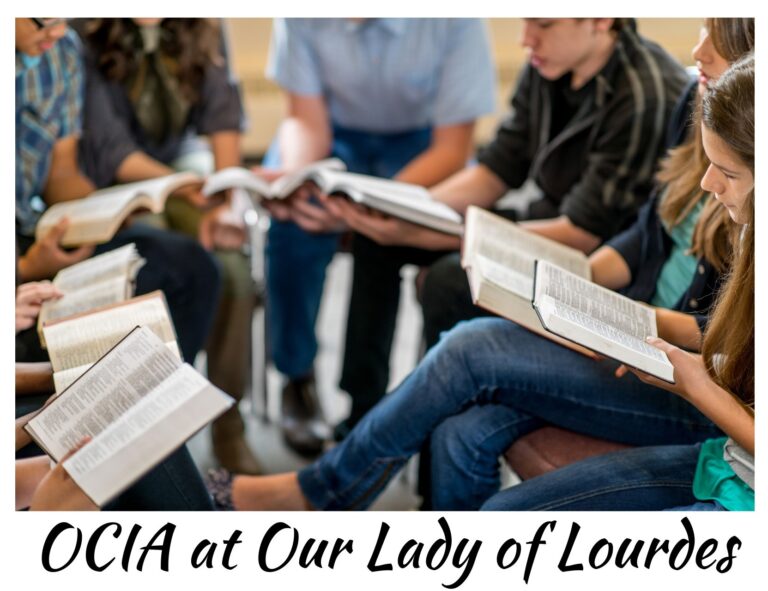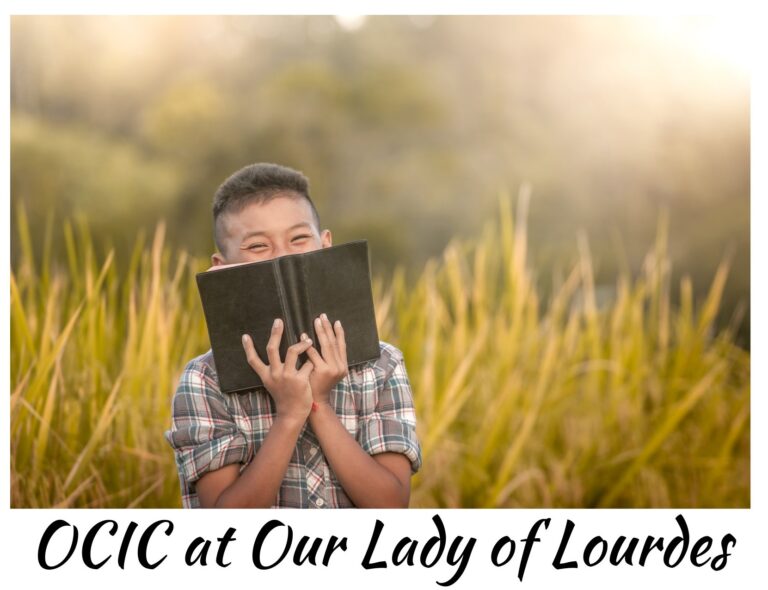
**Please note that OCIA & OCIC classes will be held within our parish family and classes will be held at St. Joseph’s Catholic parish.
OCIA (Formerly known as RCIA) is the Order of Christian Initiation for Adults
Welcome to Our Lady of Lourdes’ chapter of the Order of Christian Initiation of Adults (OCIA)! It is a great privilege to walk with you on your journey to becoming Catholic and we assure you of our commitment to make this journey as straightforward and grace-filled as possible. As a first step, please read on for a brief summary of what this process is all about. (The Order of Christian Initiation of Children [OCIC] is the same process but adapted for children.)
What is OCIA (adapted from the USCCB website)?
As is clear from the title, OCIA is the process whereby an adult is “initiated” into the “sacraments” (ultimately derived from the Greek word mysterion meaning “mystery”) of the Catholic Church. There are five steps to this initiation. They are the Precatechumenate, the Catechumenate, Purification, Enlightenment, and Mystagogy.
The Precatechumenate: If you are reading this, chances are very good that you are already in this stage, which is a time of inquiry into the Catholic Faith. This stage can take a short or long time, depending on the nature of the search and what led one to consider Catholicism in the first place.
The Catechumenate: This is the stage when you have officially joined the Church as someone who is seeking a deeper understanding of her divine mysteries. This stage formally begins with the Rite of Acceptance. Once you have completed this rite, you are joined to the Church as one of her catechumens. The next step is the request for Baptism and the celebration of the Rite of Election.
The Rite of Election is typically held on the first Sunday of Lent, when the Catechumens, their sponsors, and families, gather at the cathedral church (the church associated with the bishop). During the ceremony, the catechumens publicly express to the bishop their desire for baptism. Their names are recorded in a book, and they are called “The Elect.”
Purification: This season takes place during the days of Lent leading up to the Easter Vigil. These are marked by prayer, study, and spiritual direction for the Elect, and prayers for them by the parish communities.
Enlightenment: This season is the penultimate stage of the OCIA journey and takes place during the Easter Vigil Liturgy on Holy Saturday with the reception of the sacraments of Baptism, Confirmation and Holy Eucharist. Now the person is fully initiated into the Catholic Church.
Mystagogy: As a newly initiated Catholic, the catechumen continues his/her formation, at least until Pentecost. This is a time when the newly baptized members reflect on their experiences at the Easter Vigil and continue to learn more about the Scriptures, the Sacraments, and the teachings of the Catholic Church.
What is meant by Full Communion with the Church?
Coming into full communion with the Catholic Church describes the process for entrance into the Catholic Church for already baptized Christians. In most cases, these individuals make a profession of faith but are not baptized again. To prepare for this reception, the people, who are called Candidates, usually participate in a formation program (usually combined with OCIA) to help them understand and experience the teachings and practices of the Catholic Church. The Candidates are typically received into the Catholic Church at the Easter Vigil along with the OCIA candidates.
What is the Easter Vigil on Holy Saturday like?
The Easter Vigil takes place on Holy Saturday, the evening before Easter Sunday. This is the night that “shall be as bright as day” as proclaimed by the Exsultet, an ancient hymn of the Catholic Church (circa 400 A.D.) which is sung at the Vigil. The Liturgy of the Vigil begins with the Service of Light, which includes the blessing of the new fire and the Paschal candle, a symbol of Jesus, the Light of the World. The second part consists of the Liturgy of the Word after which the Catechumens are presented to the parish community, who pray for them during the Litany of the Saints. Next, the priest blesses the water, placing the Easter or Paschal candle into the baptismal water. Those seeking Baptism then renounce sin and profess their faith after which they are baptized with the priest pronouncing the words, “I baptize you in the name of the Father, and of the Son, and of the Holy Spirit.”
After the Baptism the newly baptized are presented with a candle lighted from the Paschal Candle. They are then Confirmed by the priest or bishop who lays hands on their heads and invokes the outpouring of the Holy Spirit. He then anoints them with the oil called Sacred Chrism. The Mass continues with the newly baptized participating in the general intercessions and in bringing gifts to the altar. At Communion, the newly baptized receive the Eucharist—Christ’s Body and Blood—for the first time.
What is the role of a godparent for an adult being baptized?
Prior to the Rite of Election, the Catechumen may choose one or two godparents, who will accompany the Catechumen on the day of Election, at the celebration of the Sacraments of Initiation, and during the Period of Mystagogy. They are called to show the Catechumens good example of the Christian life, sustain them in moments of hesitancy and anxiety, bear witness, and guide their progress in the baptismal life.
To inquire further, please contact Tracy Joy at St. Joseph’s parish. Tracy can be reached at [email protected] or 360-823-2833. Thank You!!

OCIC (Formerly known as RCIC) – Order of Christian Initiation for Children
OCIC is a program developed for children ages 7 and older who have not yet been baptized, or for older youth who missed receiving their First Holy Communion at the typical age.
For more information and/or to inquire about classes for your child, please contact Tracy Joy at St. Joseph’s Parish. Tracy can be reached at [email protected] or 360-823-2833.
